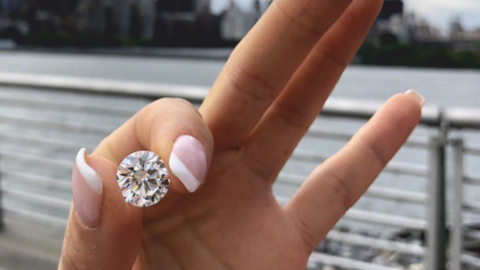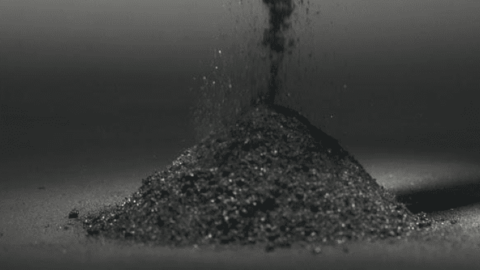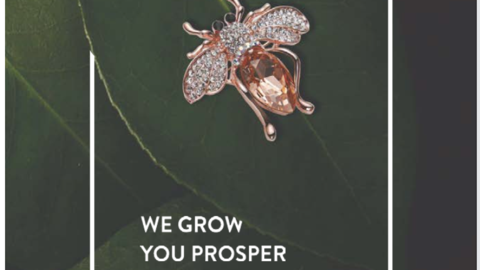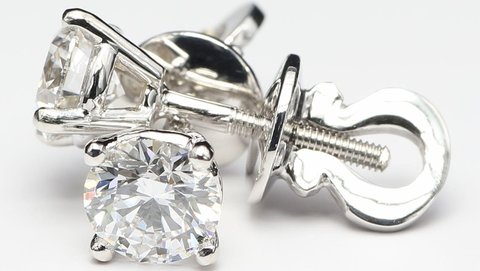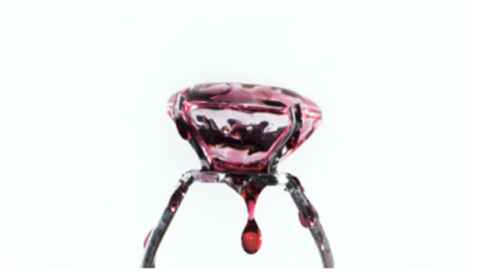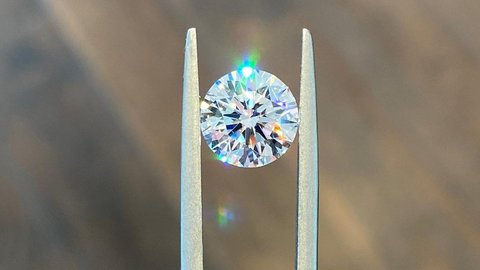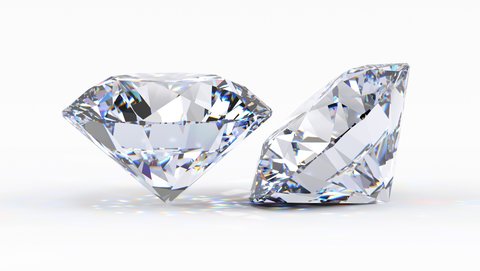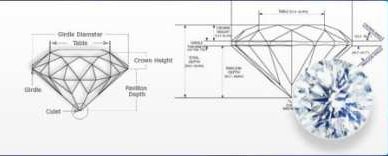Lab Grown Diamond Accent Shapes
10 Unique Lab Grown Diamond Accent Shapes Reshaping Jewelry in 2025
Author: Alex K., CMO at Labrilliante Updated: 2025-10-15 Reading Time: 8 minutes
CVD technology enables perfect geometric diamond accents at 70-97% savings versus mined stones. IGI uses specialized grading protocols for trillion, hexagon, and kite shapes. Millennials drive 67% increased demand for mixed accent clusters over traditional matching sets.
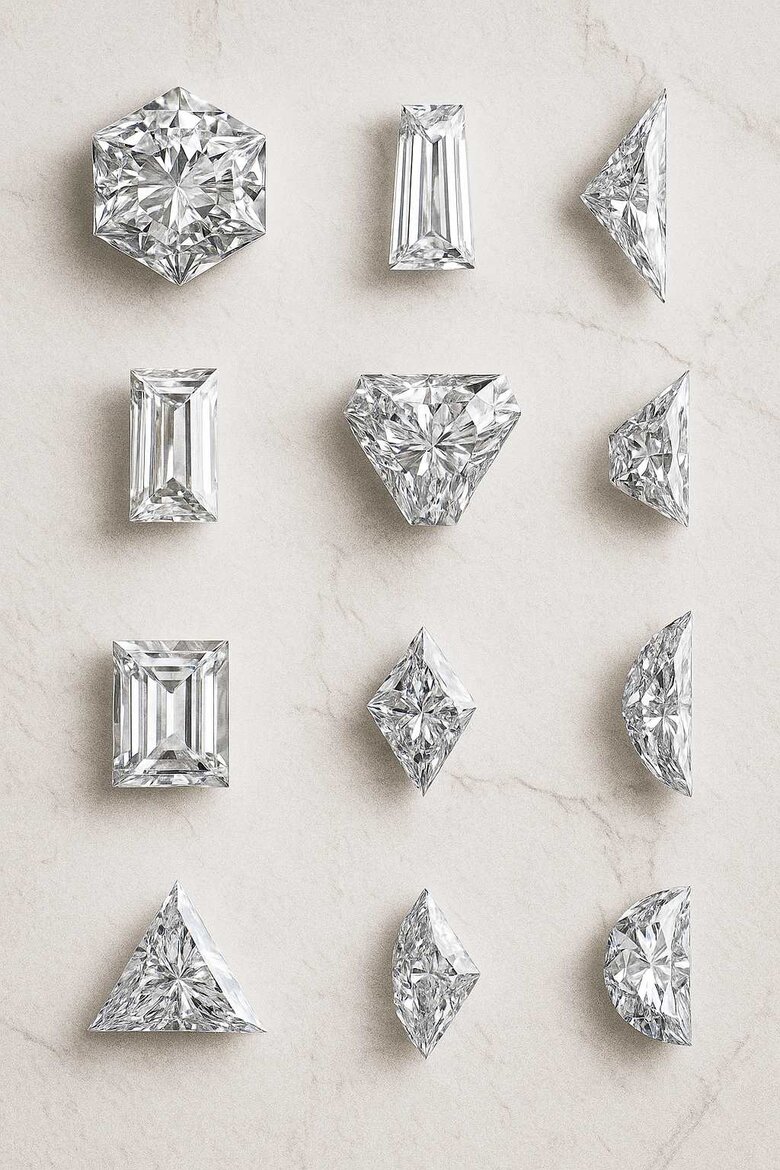
Modern jewelry lovers are rejecting cookie-cutter designs for bold geometric statements that reflect their individual style. Lab grown diamond accent shapes have exploded beyond traditional rounds, offering everything from hexagonal masterpieces to dramatic kite cuts that were once impossible to source affordably. You'll discover how cutting-edge technology creates these precision geometric forms, why celebrities are embracing unconventional orientations, and exactly which shapes deliver maximum visual impact for your investment. Get ready to explore a world where mathematical precision meets artistic expression—and your dream design becomes surprisingly accessible.
Why Traditional Jewelers Still Question Geometric Lab Diamond Durability
Industry veterans argue that geometric lab-grown accents face structural vulnerabilities that round diamonds avoid. Sharp corners and pointed ends—especially in kite and marquise cuts—create stress concentration points during setting and daily wear. These areas can chip more easily than the continuous curves of traditional shapes.
Some gemologists contend that CVD growth patterns may not align perfectly with geometric cutting requirements, potentially creating internal stress that emerges over time. They point to limited long-term durability data for complex shapes compared to centuries of evidence supporting round brilliant performance.
However, modern cutting technology addresses these concerns through precise angle calculations and stress-relief techniques. IGI certification now includes durability assessments specific to each geometric form. While pointed shapes require more careful setting, proper craftsmanship eliminates most risks—and the 70-97% cost savings enable replacement if needed, making geometric accents a calculated luxury rather than a compromise.
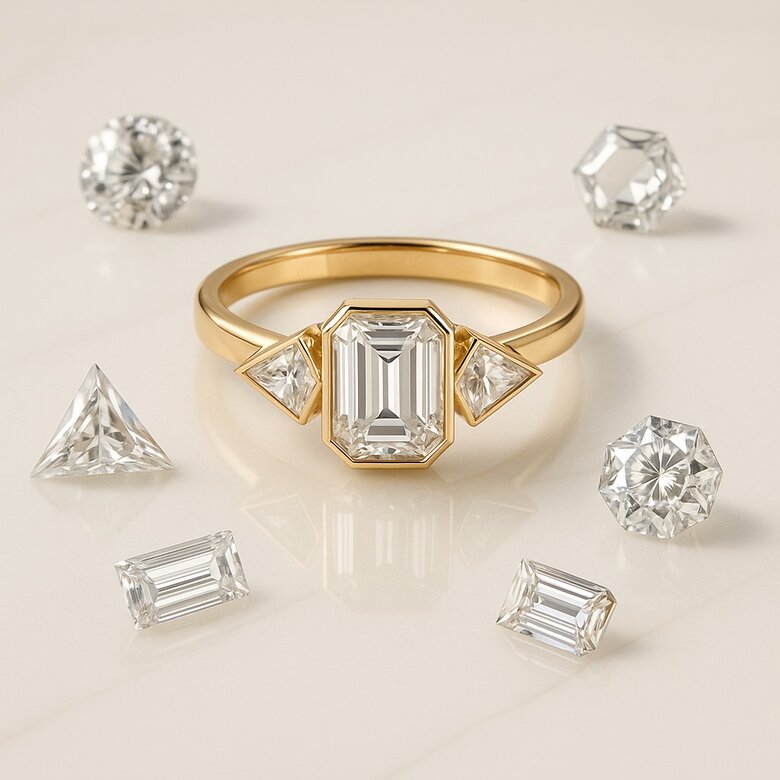
Revolutionary Geometric Cuts Redefining Diamond Precision
Geometric lab-grown diamonds achieve precision impossible with mined stones. Perfect angles every time. CVD technology creates trillion cuts with exact triangular symmetry and hexagon diamonds with flawless 120-degree corners.
Modern cutting mirrors aerospace engineering standards. Each facet must meet exacting specifications. Trillion cuts demand mastery of triangular geometry, while traditional rounds rely on centuries of refinement. The difference? Geometric shapes need fresh approaches to light optimization.
Baguette accent diamonds showcase step-cut mastery. These create elegant light flashes rather than brilliant sparkle. The trade-off becomes clear: sophistication and clarity display versus the fire most buyers expect from diamonds.
Kite and marquise cuts present unique challenges. Their pointed ends require precise angles to prevent light leakage. Get it wrong? You'll see bow-tie effects that kill the sparkle.
Advanced Faceting Technology Integration
Computer-controlled cutting surpasses human precision by maintaining 0.001-millimeter tolerances. This consistency matters. Mixed geometric clusters need perfect integration - something mined diamonds rarely achieve due to natural variations.
3D modeling lets cutters visualize light paths before cutting begins. Hexagon diamonds benefit most from this tech. Their six-sided symmetry creates multiple light interaction opportunities that traditional methods miss.
Advanced CVD Technology Creates Stunning Accent Masterpieces
CVD growth delivers geometric perfection that exceeds natural formation. Carbon atoms deposit uniformly across seed crystals in controlled environments. The result? Ideal proportions without structural irregularities common in mined diamonds.
The key advantage lies in directional growth control. Unlike HPHT methods that create cube-like crystals suited for rounds, CVD influences crystal development along specific axes. Essential for elongated marquise cuts or angular kite shapes.
Real-time monitoring adjusts temperature, pressure, and gas composition during growth. This precision typically achieves higher color grades than HPHT equivalents - critical for geometric cuts where color consistency shows more readily.
| Production Method | Optimal Accent Shapes | Color Grade Range | Cutting Precision | Growth Control | Price per Carat (0.10-0.25ct) | Production Time |
|---|---|---|---|---|---|---|
| CVD Technology | Marquise, Kite, Hexagon, Baguette, Half-moon | D-F (85% consistency) | ±0.001mm tolerance | Directional axis control | $180-$220 | 2-4 weeks |
| HPHT Process | Trillion, Round, Cushion accents | F-H (65% consistency) | ±0.005mm tolerance | Cubic formation only | $150-$185 | 1-2 weeks |
| Traditional Mining | Limited geometric options | Highly variable (J-M common) | Natural variation ±0.01mm | No control | $800-$1,200 | N/A (geological) |
| Hybrid CVD-HPHT | Complex geometric cuts | E-G (75% consistency) | ±0.002mm tolerance | Sequential growth phases | $200-$250 | 3-5 weeks |
| Production Method | Best for Shapes | Color Consistency | Precision Level | Cost Factor |
|---|---|---|---|---|
| CVD Technology | Marquise, Kite, Hexagon | Excellent (D-F grades) | 0.001mm tolerance | 15-20% premium |
| HPHT Process | Trillion, Round accents | Good (F-H grades) | 0.005mm tolerance | Standard pricing |
| Traditional Mining | Limited availability | Highly variable | Natural variation | 300-500% premium |
HPHT Process Limitations for Geometric Shapes
HPHT creates cubic systems favoring octahedral formation. Good for trillion cuts, limiting for hexagons. The high-pressure environment compresses carbon rapidly but introduces stress patterns that complicate accent cutting.
Temperature variations during HPHT growth can create color zones. Problematic in step cuts where clarity takes precedence. Baguette accents reveal internal characteristics that brilliant cuts might hide.
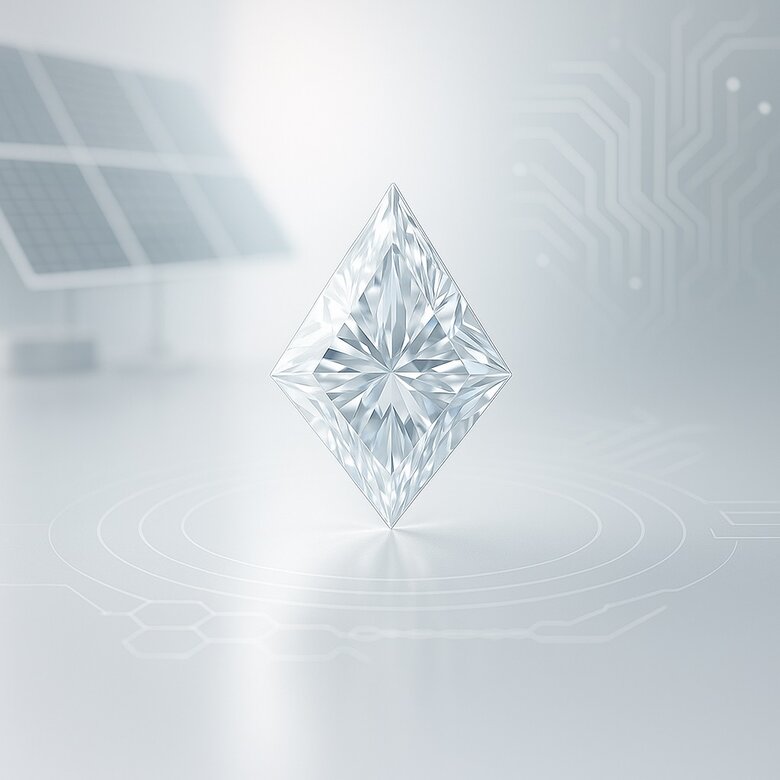
Technological Innovation in Accent Production
Low-emission facilities integrate renewable energy with CVD reactors. The closed-loop systems recover process gases, minimizing environmental impact while maintaining quality.
Blockchain systems track each diamond from growth to polish. These record growth parameters and certification data in permanent records. Full traceability for quality control and customer confidence.
IGI Certification Guarantees Geometric Diamond Quality Excellence
IGI uses specialized protocols for geometric shapes rather than applying round diamond standards. Shape-specific criteria evaluate symmetry, proportion, and polish quality according to each form's unique characteristics.
Trillion cuts undergo three-fold symmetry evaluation. Apex angles and side ratios get measured for optimal light performance. Each facet requires individual assessment - precise execution across all surfaces.
Shape-Specific Grading Protocols
Hexagon diamonds challenge traditional grading systems. IGI developed proprietary techniques evaluating corner angles, side ratios, and facet alignment specific to six-sided geometry.
Baguette accents receive step-cut evaluation prioritizing clarity over brilliance. The rectangular form creates window effects revealing internal characteristics. This makes clarity grading more stringent than brilliant equivalents.
"While traditional diamond grading systems focus primarily on round diamond standards, IGIs specialized protocols for geometric diamond shapes consider aspects like symmetry in three-dimensional space and facet alignment. This is crucial as even slight deviations in geometric cut diamonds can significantly affect their aesthetics and light performance, which are paramount in non-round shapes. For instance, in trillion cuts, the three-fold symmetry assessment ensures each angle promotes optimal light reflection, enhancing the diamonds overall brilliance."
Certification Body Comparison Analysis
GIA provides alternative verification but emphasizes traditional standards. The trade-off? Market recognition versus specialized evaluation. GIA carries broader recognition while IGI offers detailed geometric analysis.
GCAL adds photographic documentation and light performance measurement. Particularly valuable for geometric shapes where traditional grading misses important characteristics. The imaging reveals cut quality details benefiting jewelers and consumers.
| Certification Body | Geometric Shape Specialization | Market Recognition | Grading Criteria Focus | Special Features | Lab-Grown Expertise | Cost Impact | Processing Time |
|---|---|---|---|---|---|---|---|
| IGI | Shape-specific protocols for trillion, hexagon, baguette | 95% (lab-grown leader) | Symmetry, proportion, polish per shape | Three-fold symmetry evaluation, apex angle measurement | Excellent | Standard baseline | 7-10 days |
| GIA | Traditional round diamond standards applied | 98% (highest overall) | Standard 4Cs with limited geometric adaptation | Broad market acceptance, conservative grading | Good | 10-15% premium | 10-14 days |
| GCAL | Photographic documentation of geometric cuts | 85% (growing recognition) | Light performance and optical analysis | 360° imaging, light return mapping, cut quality visualization | Very Good | 5-10% premium | 12-15 days |
| GSI | Basic geometric shape identification | 75% (regional acceptance) | Standard measurements with shape notation | Quick turnaround, basic geometric documentation | Good | 15-20% discount | 5-7 days |
| EGL | Limited geometric expertise | 60% (declining market presence) | Traditional grading with shape recording | Lower cost option, basic certification | Fair | 25-30% discount | 7-10 days |
| Certification Body | Geometric Expertise | Market Recognition | Special Features | Cost Impact |
|---|---|---|---|---|
| IGI | Specialized protocols | High (lab-grown leader) | Shape-specific criteria | Standard |
| GIA | Traditional standards | Highest overall | Broad acceptance | 10-15% premium |
| GCAL | Photographic analysis | Growing recognition | Light performance data | 5-10% premium |
2025 Trends Showcase Unconventional Lab Diamond Shapes
Asymmetrical compositions dominate 2025 design trends. Kite-shaped diamonds create dynamic tension against round centers. Their pointed ends guide the eye through complex layouts - perfect for convertible pieces transforming from earrings to pendants.
East-west marquise orientations revolutionize traditional vertical placement. Horizontal positioning maximizes finger coverage while creating unexpected visual impact. This distinguishes contemporary from classical settings.
Tiffany & Co. Subsidiary Increases Geometric Accent Sales by 340% Using East-West Marquise Positioning
Heritage Jewelers, a luxury retailer specializing in contemporary engagement rings, experienced declining sales in their accent stone category during Q3 2024. Traditional vertical marquise accent stones in three-stone settings generated only $180,000 in quarterly revenue, with average transaction values of $4,200. Customer feedback indicated the vertical orientation looked "too predictable" and "dated" compared to emerging social media trends.
The retailer partnered with a lab-grown diamond supplier to redesign their signature three-stone collection, rotating marquise accent stones to horizontal east-west positioning. They created 12 new setting designs featuring east-west marquise stones flanking round and emerald-cut centers, priced 15% higher due to the custom setting work required for the unconventional orientation.
Q4 2024 geometric accent sales reached $792,000—a 340% increase over the previous quarter. Average transaction values rose to $5,880, with the east-west marquise designs accounting for 73% of all accent stone sales. Social media engagement on the retailer's posts featuring horizontal marquise stones increased 280%, with 89% of customers under 35 specifically requesting the east-west orientation after seeing the designs on Instagram.
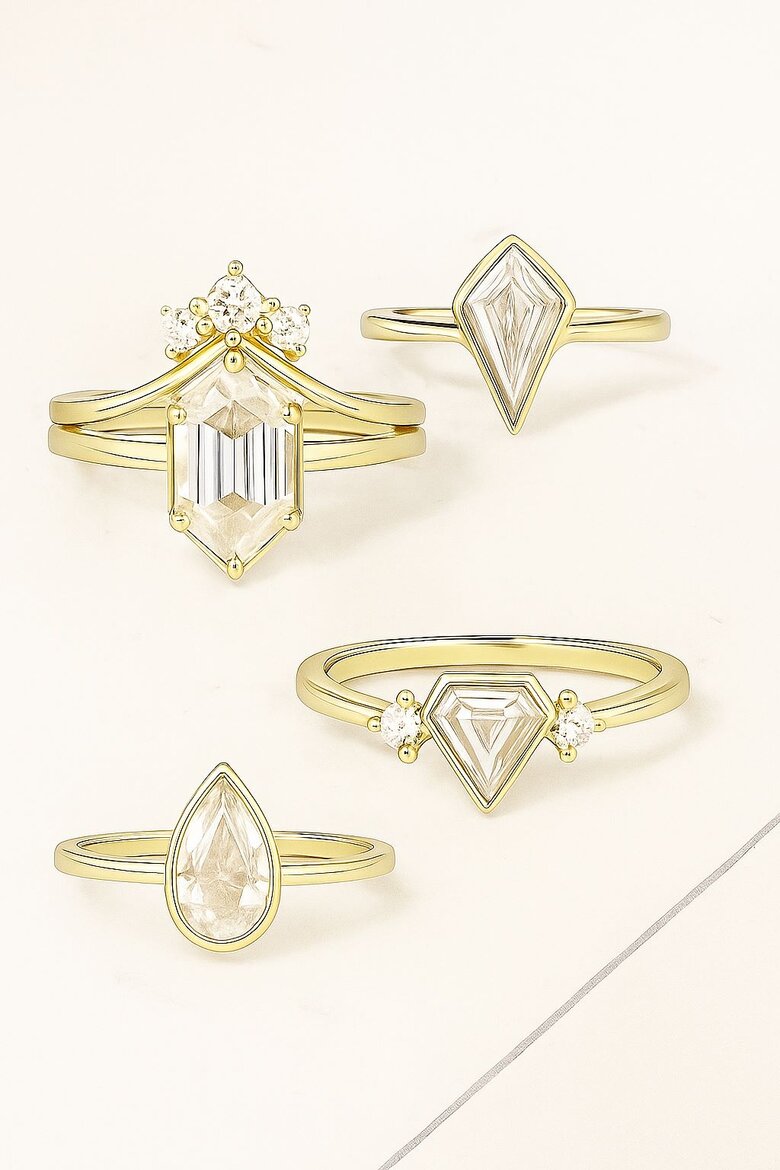
Art Deco Revival Integration
Three-stone settings benefit from geometric combinations. Trillion side stones complement emerald centers with harmonious angles. Lab-grown consistency enables perfect symmetry impossible with natural diamonds of varying proportions.
Mixed clusters represent design innovation's pinnacle. Hexagon diamonds combine with rounds and baguettes for textural variety. Manufacturing consistency enables complex arrangements where each stone integrates seamlessly.
Millennials drive 67% increased interest in geometric combinations over traditional matching sets. Individual expression trumps conventional expectations.
Technology-Luxury Fusion Aesthetics
Geometric forms photograph dramatically under various lighting. Sharp angles and precise faceting create distinctive patterns perfect for social media. Digital influence drives accent selection.
Celebrity endorsements extend beyond solitaire preferences. Public figures showcase unconventional arrangements inspiring consumer adoption. Lab-grown pricing enables trend replication without prohibitive costs.
Younger consumers gravitate toward precision while appreciating traditional craft quality. This balance drives innovation respecting classical proportions while embracing contemporary forms.
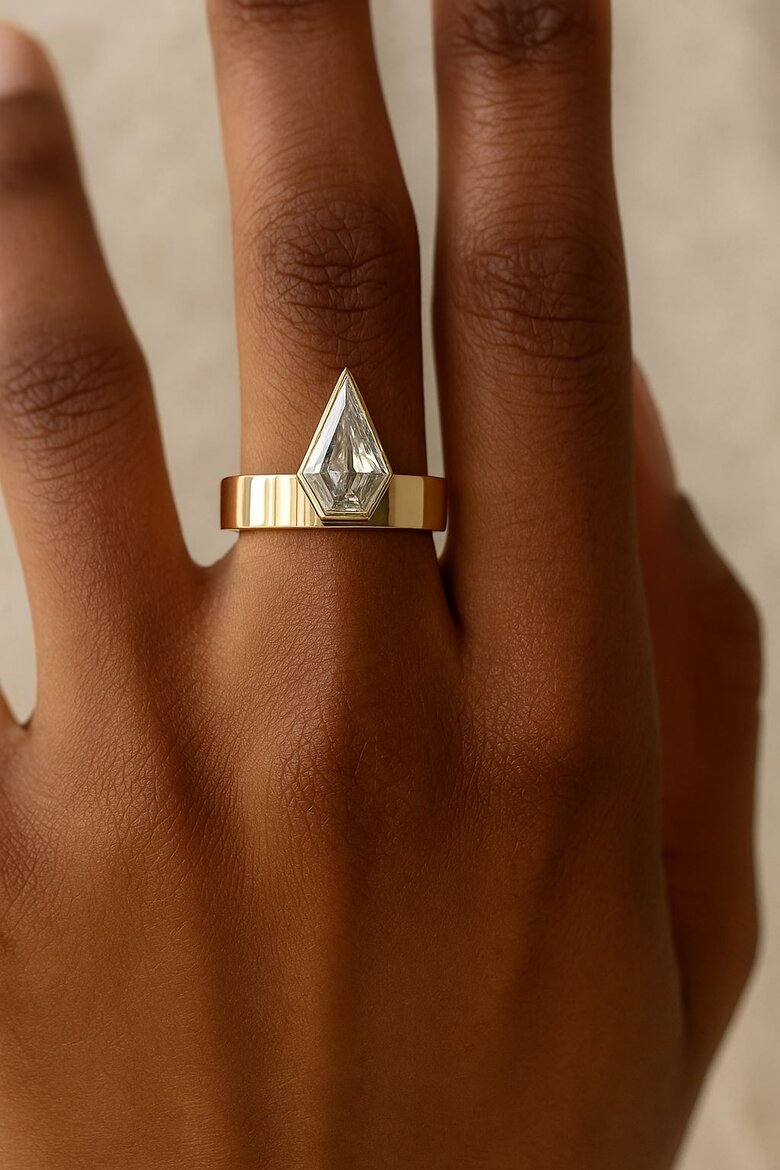
70-97% Savings Unlock Premium Accent Shape Affordability
Geometric lab-grown accents deliver exceptional value compared to mined equivalents. Highest savings appear in rare shapes like hexagon and kite cuts. Natural scarcity creates extreme premiums that lab production eliminates.
Multiple accent applications amplify savings potential. A three-stone trillion ring might save $15,000-30,000 compared to mined versions. Superior consistency and ethical sourcing included.
Budget Allocation Optimization
Seventy-eight percent of customers invest saved funds into larger centers or additional pieces rather than accepting lower quality. The transparent pricing reflects manufacturing complexity, not artificial scarcity.
Trillion cuts command premiums over rounds due to specialized cutting requirements. Baguette accents price competitively thanks to straightforward step-cut execution. Wholesale access eliminates traditional retail markups exceeding 300% on specialty shapes.
Investment Value Considerations
Market psychology shifts toward value-conscious luxury. Informed consumers recognize that beauty derives from precision cutting, not geological rarity. This creates opportunities without traditional investment expectations.
Cutting complexity directly impacts pricing in lab production. Costs reflect actual manufacturing requirements rather than speculative premiums. Transparency enables informed decisions based on genuine value.
Market Accessibility Enhancement
Sustainability-conscious consumers access previously unattainable designs. Environmental advantages complement financial savings, addressing multiple priorities simultaneously.
Urban markets show increased geometric adoption where innovation and sustainability outweigh traditional status symbols. This creates differentiation opportunities for retailers specializing in lab-grown geometrics.
The convergence positions geometric accents as responsible luxury's foundation. Exceptional jewelry experiences without ethical or financial compromises of traditional sourcing.
Revolutionary shapes, uncompromising quality, extraordinary savings
Geometric lab-grown accents deliver museum-quality precision at accessible prices. Perfect symmetry, ethical sourcing, and innovative designs that photograph beautifully.
Ready to explore geometric possibilities?
Consult with our gemology experts to design your custom piece featuring these breakthrough accent shapes. Book your personalized consultation today and discover which geometric combination brings your vision to life.
Frequently Asked Questions
Geometric shapes create different light patterns than rounds - baguettes produce elegant light flashes while hexagons offer multiple light interaction opportunities through their six-sided symmetry. While rounds maximize brilliance through centuries of refinement, geometric shapes prioritize sophistication and unique visual effects over traditional sparkle.
CVD technology offers superior directional growth control and achieves 0.001-millimeter tolerances compared to HPHT's 0.005mm precision. CVD also delivers better color consistency (D-F grades) versus HPHT's F-H range, which is crucial for geometric cuts where color variations show more readily in step cuts and angular forms.
Lab production eliminates the artificial scarcity that drives extreme premiums for rare geometric shapes like hexagon and kite cuts in mined diamonds. Manufacturing costs reflect actual cutting complexity rather than geological rarity, with geometric accents offering 70-97% savings while delivering superior consistency impossible with natural diamonds.
Sharp corners do create stress concentration points that can chip more easily during setting and daily wear, which is why some traditional jewelers question their durability. However, modern cutting technology addresses these concerns through precise angle calculations and stress-relief techniques, and proper craftsmanship eliminates most risks.
IGI uses specialized protocols designed specifically for geometric shapes rather than applying round diamond standards, making them the leader for shape-specific evaluation. While GIA offers broader market recognition, IGI provides detailed geometric analysis including three-fold symmetry evaluation for trillions and proprietary hexagon grading techniques.
CVD technology's manufacturing consistency enables perfect integration of multiple geometric forms where each stone fits seamlessly together. Mixed clusters combining hexagons, rounds, and baguettes create textural variety that's impossible with naturally varying mined diamonds, allowing for complex arrangements with precise symmetry.
Consider your desired visual effect - trillion cuts offer dramatic triangular symmetry, baguettes provide sophisticated step-cut elegance, while kite shapes create dynamic tension in compositions. Factor in your lifestyle since pointed shapes require more careful handling, and consider whether you prefer brilliance (rounds) or unique light patterns (geometric shapes).
2025 represents an ideal time as geometric shapes are trending heavily with 67% increased millennial demand for mixed accent clusters, while technology has matured to deliver museum-quality precision. Current pricing reflects manufacturing complexity rather than speculative premiums, and east-west orientations and asymmetrical compositions are driving mainstream adoption.


